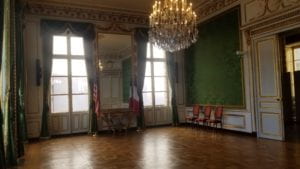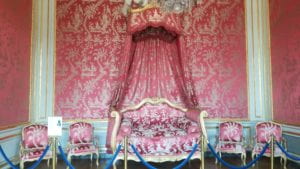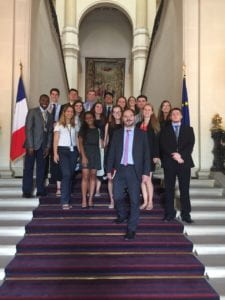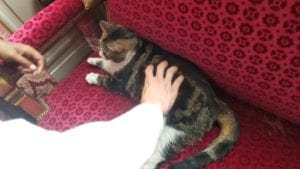Yesterday we visited the George C. Marshall Center in Hôtel de Talleyrand, the US Embassy, and the French Ministry of Foreign Affairs.
Our first stop was my favorite of the day. The Hôtel was built in 1767 for the comte de Saint-Florentin, however the building bears the name of famous French diplomat Charles-Maurice Talleyrand who lived and died there. This building is not open to the public except for on heritage day in France when they greet thousands of guests. I can imagine people standing shoulder to shoulder trying to get a glimpse of the intricate panels and fireplaces in each tiny room. I feel very privileged to have visited this building in such a private circumstance. The Talleyrand Hôtel is unique in that it holds multiple rich histories. We learned about Talleyrand’s life and activities at the same time as we imagined desks packed into a room while people worked on the Marshall plan.
Our guide explained that when the Hôtel was built, it w as on the outskirts of the city. If you had a lot of money, it was better to build your mansion far away from the overcrowded and dirty city center. One of the first rooms we saw had an Asian theme to the wall paper. Our guide explained that it was very fashionable to display this style at the time as trade between France and Asia had just opened. Then, we saw a room with big green curtains called the grand reception room. From the window we could see the obelisk which our guide told us was either a gift to Napoleon or a stolen good depending on who you talk to. The guillotine stood in that square during the Reign of Terror and it is also marks the beginning of the French Revolution. The next room was the State Office where the most important people were received by Talleyrand. This room had the most gold leaf on the walls and ceiling and was where the most important people worked during the creation of the Marshall Plan. The next room we saw was an addition by the Rothchild family who lived there for one hundred years. While the Hôtel was being renovated, one of the last Rothchilds recounted having breakfast in that room with his nanny. He also remembered a secret staircase he used to climb down from his room to get to the lower levels of the house. I was able to find the door to the staircase
when I ducked back into the other room. (This is very exciting as I have dreamed of secret passageways since I was a little girl) Finally, we saw the room where many talks and speeches were given during the Marshall plan. After a few words from Dr. Birchfield about the significance of George C. Marshall and what he meant to the reconstruction of Europe and its relationship to the US, we headed to the US embassy.


The US embassy security made airport security look like a walk in the park. We were relieved of our passports, phones, headphones, chargers etc. and shuttled through two metal detectors. We arrived in a beautiful conference room where we sat in comfy chairs around a big table. We learned that this is the oldest US Embassy that was specifically built to be a US embassy. We could even see the letters USA woven into the original wallpaper. There, we met Kevin O’Connor from Strategic Communication and Phaedra Gwyn from African Regional Services. They gave us a glimpse into the life of a foreign service officer. Both of them spoke several languages and have lived all over the world. Ms. Gwyn, who currently works for African Regional Services, used to live in South Sudan in a “tricked out storage container.” She told us about her experience in Turkey being a black woman speaking Turkish. She said that she was able to get a lot of people to listen to her just because of who she was.
We learned about their paths and what it takes to become a foreign service officer. There is a test called the Foreign Service test which consists of a general knowledge section and a practical understanding section. After you pass this portion, there is an oral and IQ exam in DC. Both Mr. O’Connor and Ms. Gwyn failed some part or all of this exam before eventually passing. Their stories were the perfect mix of exciting and practical. I think we got a good understanding of what it is like to work in this part of government: usually not glamorous but certainly exciting and fulfilling.
After regaining possession of our passports and electronics, we took a break for lunch. A group of us stopped at a take-away restaurant where we got sandwiches and other goodies. We had a picnic in the garden in between the Seine and Hôtel des Invalides. Dr. Birchfield told us a little about the historic buildings surrounding us and we took a group picture with Hôtel des Invalides in the background.
After a short walk across the street we entered the Ministry of Foreign Affairs. We were greeted by the friendliest little cat who wanted as much attention as it could get. We originally planned on visiting the Ministry of Foreign Affairs two days ago but I thought this was much better timing. It was interesting to learn the French perspective on topics we have been studying for the past ten weeks just after hearing from the US embassy. It seems that our countries agree on many things but still have important differences. Both the Embassy and the Ministry taught us how important it is to work past these differences in order to preserve a strong alliance. Our speaker talked a little about the difference between an ally and a partner and symbology of each word. He told us an ally is someone who agrees on most foreign policy while a partner has major differences. Some countries who share similar foreign policy, like Morocco, are only partners because of historical reasons that need to be respected. I found this anecdote to be particularly symbolic of the work of diplomats. Word choice and interpersonal communication is everything. 

Today’s site visits taught us about the world of diplomacy in the nineteenth century, after World War II and now. Though government buildings are often dazzling, diplomacy is more than appearances. It takes a great deal of interpersonal skills, knowledge of the world, and nuance to affect change. It was a great privilege to visit some places most Parisians have never seen and hear from people on the front lines of diplomacy.


















